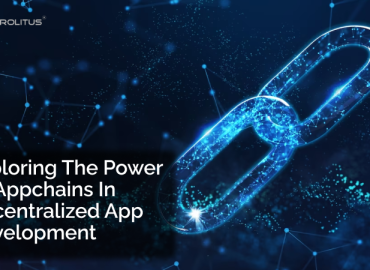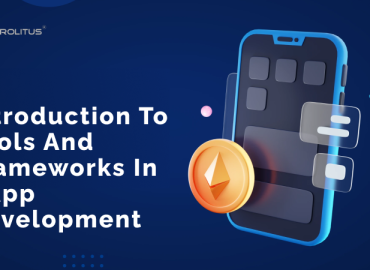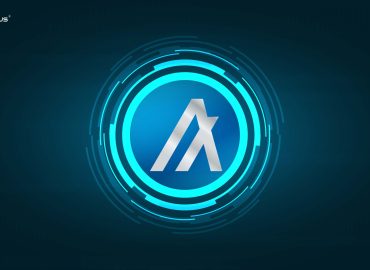Introduction to Appchains and Their Role in DApp Architecture
In the rapidly evolving world of blockchain technology, innovation is the name of the game. As the demand for decentralized applications (DApps) continues to surge, so does the need for more efficient, scalable, and flexible infrastructures to support them. This is where Appchains come into play, revolutionizing DApp architecture and opening up new horizons for blockchain developers and users alike.
Appchains, short for “Application Chains,” represent a groundbreaking development in the blockchain ecosystem. They are purpose-built, sidechain-like structures designed to cater specifically to the needs of individual DApps or groups of DApps. These innovative chains are transforming the way we think about blockchain architecture by providing tailored solutions for DApp developers, addressing some of the key limitations of traditional blockchains.
In this blog, we will explore the exciting world of Appchains, delving into their unique characteristics, how they function, and most importantly, the pivotal role they play in redefining DApp architecture. From scalability and performance enhancements to increased customization and security, Appchains offer a promising future for the blockchain industry, pushing the boundaries of what’s possible in decentralized application development. Join us on this journey to discover how Appchains are reshaping the landscape of DApps and blockchain technology as a whole.
What Are Appchains and How Do They Work?
Appchains, short for “Application Chains,” are a novel concept in the blockchain space designed to optimize and enhance the performance of decentralized applications (DApps) by tailoring blockchain infrastructure to their specific needs.
Appchains are a dynamic and adaptable solution that empowers DApp developers to create blockchain networks optimized for their unique use cases. By offering scalability, customization, and independence, Appchains are playing a crucial role in redefining DApp architecture and driving innovation in the blockchain industry. They enable developers to build high-performance, purpose-specific DApps while contributing to the overall growth and diversity of the blockchain ecosystem.
How do they work?
To understand how Appchains work, let’s break down their key components and operational principles:
- Purpose-Built Chains: Appchains are custom blockchain networks created with a particular DApp or a group of related DApps in mind. Unlike traditional blockchains that serve a wide range of applications, Appchains are purpose-built, making them highly specialized and efficient.
- Consensus Mechanism: Appchains can choose their own consensus mechanisms, tailored to the needs of the DApp they support. This flexibility enables them to prioritize speed, security, or other specific attributes, depending on the DApp’s use case.
- Interoperability: While Appchains are independent, they can still communicate and interact with the main blockchain and other Appchains when necessary. This interoperability ensures that assets and data can be transferred seamlessly between different chains, promoting a cohesive ecosystem.
- Resource Management: Appchains manage their resources independently, including network bandwidth, storage, and computational power. This isolation prevents resource contention between DApps and allows for more predictable and efficient performance.
- Customizable Rules: DApp developers have greater control over the rules and parameters of their Appchains. This customization extends to token standards, consensus rules, governance structures, and more. Developers can tailor their Appchains to meet specific requirements and adapt as needed over time.
- Security: Appchains inherit security features from the main blockchain but can also implement additional security measures tailored to the DApp’s needs. This ensures that sensitive data and assets are protected.
- Decentralization: Appchains typically maintain a level of decentralization, but this can be adjusted based on the DApp’s objectives. Some DApps may prioritize higher decentralization, while others may require a more controlled environment.
Appchains vs. Traditional Blockchains: A Comparative Analysis
Comparing Appchains to traditional blockchains highlights some key distinctions that showcase the advantages and unique capabilities of Appchains. Below is a comparative analysis of Appchains and traditional blockchains:
- Purpose and Specialization:
Appchains: Purpose-built for specific DApps or groups of related DApps, offering high specialization and customization.
Traditional Blockchains: General-purpose networks designed to support a wide range of applications, lacking the same level of specialization.
- Consensus Mechanism:
Appchains: Can select consensus mechanisms tailored to their specific needs, optimizing either for speed, security, or other attributes.
Traditional Blockchains: Generally use a single consensus mechanism across the entire network, which may not be ideal for every DApp.
- Resource Management:
Appchains: Manage their own resources, including network bandwidth, storage, and computational power, preventing resource contention.
Traditional Blockchains: Share resources among all DApps, potentially leading to congestion and performance issues during high demand.
- Customization:
Appchains: Offer high levels of customization, allowing DApp developers to define token standards, consensus rules, governance structures, and more.
Traditional Blockchains: Have standardized rules and protocols that apply uniformly to all applications, limiting customization options.
- Security:
Appchains: Inherit security features from the main blockchain and can implement additional security measures tailored to their DApp’s needs.
Traditional Blockchains: Provide a baseline level of security but may not be optimized for the specific security requirements of individual DApps.
- Decentralization:
Appchains: Can adjust their level of decentralization based on the DApp’s objectives, offering flexibility.
Traditional Blockchains: Generally aim for a consistent level of decentralization across the network.
Appchains offer a tailored approach to blockchain architecture, addressing some of the limitations of traditional blockchains for DApp development. Their specialization, scalability, and customization options make them well-suited for specific use cases, while traditional blockchains remain versatile solutions for a wide array of applications. The choice between Appchains and traditional blockchains depends on the unique requirements and objectives of a DApp project.
The Benefits of Appchains for DApp Developers
DApp developers stand to gain numerous benefits from leveraging Appchains in their projects. These benefits address many of the challenges and limitations they encounter when developing on traditional blockchains. Here are some of the key advantages of Appchains for DApp developers:
- Scalability: Appchains offer independent scalability, meaning each DApp can scale its chain according to its specific requirements. Developers no longer need to compete for limited resources on a shared blockchain, ensuring optimal performance even during high-demand periods.
- Customization: Appchains provide a high degree of customization. DApp developers can tailor the chain’s parameters, consensus mechanisms, token standards, and governance rules to precisely match their project’s needs. This flexibility fosters innovation and enables developers to experiment with new ideas.
- Performance Optimization: Appchains allow developers to optimize their chains for performance and efficiency. They can choose consensus mechanisms that prioritize speed, reducing transaction confirmation times and improving the user experience.
- Resource Management: With independent resource management, DApps on Appchains can efficiently allocate network bandwidth, storage, and computational resources. This minimizes resource contention issues and ensures predictable performance.
- Focused Development: DApp developers can concentrate on building and improving their DApps without needing to worry about the broader blockchain infrastructure. This allows for more focused and efficient development efforts.
- Reduced Costs: Appchains can lead to cost savings by eliminating the need for DApps to compete for transaction space, which can drive up fees on congested networks. Developers can optimize their chain’s resources, reducing operational expenses.
- Innovation and Experimentation: Appchains encourage innovation by providing a sandbox environment for DApp experimentation. Developers can try out new consensus mechanisms, tokenomics, and governance models without affecting the main blockchain.
- Community Building: By developing on an Appchain, DApp creators can foster a dedicated community of users and contributors who are interested in the unique aspects of their project. This can lead to more engaged and passionate supporters.
Appchains offer DApp developers a versatile and empowering platform to create high-performance, customized, and scalable decentralized applications. By addressing many of the limitations of traditional blockchains, Appchains enable developers to push the boundaries of innovation while delivering improved user experiences. This newfound flexibility and efficiency are driving the adoption of Appchains as a pivotal tool in the DApp development landscape.
The Future Outlook: How Appchains Are Shaping the DApp Landscape
The future outlook for Appchains in shaping the decentralized application (DApp) landscape is remarkably promising. As blockchain technology continues to evolve and mature, Appchains are emerging as a critical tool that will play a significant role in the following ways:
- Scalability Solutions: Scalability remains a persistent challenge for blockchain networks. Appchains, with their independent scalability features, will contribute to a more scalable and responsive DApp ecosystem. This is crucial for accommodating the growing number of users and transactions.
- Improved User Experience: DApps running on Appchains will offer improved user experiences due to faster transaction confirmation times, lower fees, and enhanced performance. This will make blockchain-based applications more appealing to mainstream users.
- Reduced Environmental Impact: Some Appchains may prioritize energy efficiency, addressing concerns about the environmental impact of blockchain technology. This eco-friendly approach will resonate with users and regulators alike.
- Decentralized Finance (DeFi): Appchains will continue to support the growth of DeFi projects by offering dedicated chains for various financial applications, including lending, borrowing, trading, and yield farming.
- Governance and DAOs: Appchains can facilitate more flexible governance structures, enabling Decentralized Autonomous Organizations (DAOs) to thrive. These DAOs will have the autonomy to make decisions tailored to the specific needs of their DApps.
- Security Innovations: As Appchains become more prevalent, security innovations will evolve to protect assets and data on these specialized chains. This will enhance trust and confidence in the DApp ecosystem.
- Global Adoption: Appchains are not limited by geographical boundaries, making them accessible to a global user base. As adoption grows, Appchains will contribute to a more decentralized and borderless digital economy.
Appchains are poised to reshape the DApp landscape by addressing critical challenges and unlocking new possibilities for developers and users. As blockchain technology continues to mature, the versatility, scalability, and customization offered by Appchains will be instrumental in driving innovation and expanding the reach of decentralized applications across various industries. The future of DApps is undoubtedly intertwined with the evolution and widespread adoption of Appchains.
Innovations and Trends in Appchain Development
Appchain development is a dynamic and evolving field within the blockchain space. To stay at the forefront of innovation and meet the demands of DApp developers and users, Appchain development continues to witness several key innovations and trends:
- Cross-Chain Compatibility
Interoperability between Appchains and different blockchains is a growing trend. Developers are working on standard protocols and technologies like bridges and cross-chain communication tools to facilitate seamless asset transfers and data exchange between various blockchain networks.
- Layer 2 Solutions
Layer 2 solutions, such as state channels and sidechains, are being integrated into Appchain development. These solutions enhance scalability, reduce transaction costs, and improve overall DApp performance by processing transactions off-chain or on specialized chains.
- Delegated Proof of Stake (DPoS)
DPoS consensus mechanisms are gaining popularity in Appchain development due to their speed and efficiency. DPoS-based Appchains offer fast transaction confirmations and energy-efficient validation, making them attractive for high-throughput DApps.
- NFT-Focused Appchains
With the surge in non-fungible tokens (NFTs), some Appchains are being tailored specifically for NFT marketplaces and DApps. These Appchains offer unique features and standards optimized for the creation, trading, and management of digital collectibles.
- Oracles and Data Feeds
Appchains are integrating oracles and data feeds to access real-world information for DApps. These oracles provide trusted data inputs for various use cases, including DeFi, prediction markets, and supply chain management.
- Cross-Chain DeFi
Appchains are enabling cross-chain decentralized finance (DeFi) by creating bridges to connect with established DeFi ecosystems on other blockchains. This trend promotes liquidity and asset interoperability.
- Energy Efficiency
Sustainability is a growing concern, leading to the development of energy-efficient Appchains. These chains employ consensus mechanisms that consume less energy while maintaining security and decentralization.
- Enhanced Developer Tooling
Robust developer tooling, including integrated development environments (IDEs), testing frameworks, and analytics tools, is being developed to streamline the Appchain development process and improve code quality.
- User-Friendly Wallets and Interfaces
User-friendly wallets and interfaces are being designed to make it easier for users to interact with DApps on Appchains. Improved user experiences will be crucial for broader DApp adoption.
As Appchain development continues to evolve, these innovations and trends will shape the future of decentralized applications. Developers and organizations in the blockchain space will need to stay informed and adapt to these advancements to create innovative and user-centric DApps on Appchains.
The Final thought: The Promising Future of Appchains in Blockchain Technology
In conclusion, the future of Appchains in blockchain technology is exceptionally promising, as these purpose-built chains continue to reshape the landscape of decentralized applications (DApps) and address critical challenges in the blockchain ecosystem. Appchains offer a range of benefits, innovations, and trends that are set to revolutionize how DApps are developed, deployed, and experienced.
The promising future of Appchains reflects the dynamic nature of the blockchain industry, where continuous innovation and adaptability are paramount. As blockchain technology continues to mature, Appchains are poised to play a central role in addressing the evolving needs of DApp developers and users. Their ability to provide scalability, customization, and efficiency while fostering interoperability and security will contribute to a more decentralized, efficient, and inclusive digital economy. In this rapidly evolving landscape, Appchains are a testament to the blockchain community’s commitment to pushing the boundaries of what’s possible and unlocking the full potential of decentralized applications.





